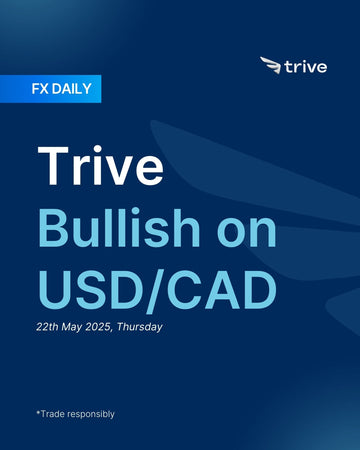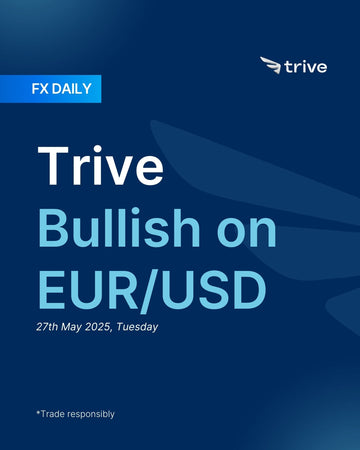FX Weekly: Trive’s Week Ahead Views

This week focus will be on the highlights include Fed Minutes, US PCE, Canada GDP, Tokyo CPI, Australian CPI, RBNZ rate decision, and the OPEC JMMC.
RBNZ Announcement (Wed):
RBNZ is expected to lower rates for the sixth consecutive meeting next week with money markets pricing in a 91% probability that the central bank will cut the OCR by 25bps to 3.25% and with just a 9% chance for rates to be kept unchanged at the current level. As a reminder, the RBNZ lowered the OCR by 25bps to 3.50% at the last meeting in April, as unanimously forecast and which the central bank had pre-signalled, while it noted at that meeting that a further reduction in the OCR is appropriate and as the extent of tariffs becomes clearer, the Committee has scope to lower the OCR further. RBNZ also stated that global trade barriers weakened the outlook for global growth and that having CPI close to the middle of the target band puts the committee in the best position to respond to developments.
Furthermore, the minutes from the meeting stated that future policy decisions will be determined by the outlook for inflationary pressure over the medium term. It stated that the monetary policy response to tariffs will focus on the medium-term implications for inflation but added that the implications of increased tariffs for global and domestic inflation are more ambiguous. The rhetoric from officials since then has continued to highlight trade and tariff-related uncertainty as RBNZ Governor Hawkesby noted that the threat of a trade war has decreased recently but there is still considerable uncertainty about how things will play out and that supply-side impacts from tariffs could impact New Zealand significantly. RBNZ Chief Economist Conway also commented that higher tariffs and uncertainty about global trade policy mean economic activity globally and in New Zealand will most likely be weaker than expected and that the balance of risks had shifted to the downside.
As such, the central bank is expected to continue with its current rate-cutting cycle to support the economy amid the ongoing global trade uncertainty, while the recent key data releases since the last meeting have been mixed and therefore are unlikely to derail the central bank from its current path.
FOMC Minutes (Wed):
The FOMC left rates unchanged at 4.25–4.50%, as expected, with a unanimous vote. The statement noted that uncertainty around the economic outlook has increased further and added that “risks of higher unemployment and higher inflation have risen”. The Fed repeated its March language that economic activity continues to expand at a solid pace, though net export swings have affected the data. It maintained its view that inflation remains somewhat elevated and labour market conditions are solid, with the unemployment rate stabilising at a low level. The key changes centred on increased uncertainty and the risks on both sides of the dual mandate.
In his press conference, Chair Powell reiterated that the Fed is well-positioned to respond as needed and remains in a “wait-and-see” stance. On tariffs, he noted they have been larger than anticipated but have yet to show major effects in the data, though concerns remain. Powell said the Fed will adjust policy as the economy evolves, balancing dual mandate goals by assessing how far and how fast each side may drift from target. He declined to specify which side is at greater risk and stressed the Fed is in no rush but can act quickly if necessary.
Note, the minutes of the meeting are an account of information that was available to them at the time of the meeting on 7th May 2025, therefore it will not incorporate the recent de-escalation on trade with China.
OPEC JMMC (Wed):
OPEC+ will convene its Joint Ministerial Monitoring Committee (JMMC) on Wednesday ahead of the full ministerial meeting on June 1st, with delegates reportedly discussing the prospect of a third consecutive output hike, according to Bloomberg sources. Sources suggest a potential 411k BPD increase for July is under consideration — three times the originally scheduled monthly hike — although no final decision has yet been reached. The move would maintain Saudi’s recent strategy of accelerating supply additions in an effort to enforce discipline on members exceeding quotas. At the last meeting, Saudi Arabia issued a firm warning to overproducing nations, threatening further output increases unless compliance improves.
Australian CPI (Wed):
Markets expected the monthly CPI indicator at 2.3% Y/Y (prev. 2.4%). Westpac is forecasting a 0.3% rise in the April Monthly CPI Indicator - which will take the annual pace down to 1.9%. Australia’s CPI data will be closely watched following the RBA’s expected 25bps rate cut earlier in May, which brought the Cash Rate to 3.85%. The RBA noted that while inflation is moderating, the outlook remains uncertain, with the risks to inflation now seen as more balanced. The cut was accompanied by a downgrade in global growth forecasts and trimmed domestic core inflation projections in the central bank’s quarterly update. The Q1 CPI print showed headline inflation at 2.4% Y/Y, steady from the prior quarter, while core inflation fell into the RBA’s 2–3% target band for the first time since 2021, at 2.9% Y/Y. However, price pressures remain in non-discretionary items like electricity, food, health, and education, which drove a 0.7% Q/Q rise in core CPI. A softer April print would validate the RBA’s dovish tilt, supporting expectations for two more rate cuts in H2 2025, as per market pricing. Conversely, stickier inflation in key components could complicate the easing path. At the May meeting presser, Governor Bullock revealed that the board discussed cutting by 25bps or 50bps.
Tokyo CPI (Fri):
There is currently no consensus for the Tokyo CPI release, which is seen as a leading indicator to the National CPI typically released a couple of weeks later - the data will be closely watched as a leading signal for national price trends. ING expects inflationary pressures to remain broad-based, with core CPI likely rising slightly amid steady headline inflation. The data comes at a delicate time for the BoJ, which faces mounting policy complexity due to sticky inflation and weakening industrial output, the latter pressured by recent US auto tariffs.
US PCE (Fri):
April’s CPI and PPI data suggest core PCE inflation softened in April. Core CPI rose +0.2% M/M, below expectations for +0.3%, while core PPI unexpectedly fell 0.4% M/M. Together, they imply the core PCE deflator increased by just 0.12% M/M (prev. 0.0%), according to Pantheon Macroeconomics, bringing the annual rate down to 2.5% Y/Y from 2.6%. For the headline rate, Fed Chair Powell has predicted that April PCE was likely around 2.2% Y/Y (vs 2.3% in March), albeit this did not incorporate the latest PPI report. The deceleration in Core PCE largely reflects sharp PPI drops in portfolio management prices, which is heavily weighted in the PCE calculation.
Looking ahead, core PCE inflation is still expected to peak between 3.0% and 3.5% later this year, Pantheon writes, assuming current tariffs persist. It says that while tariffs may add around 1ppts to goods prices, this is likely to be offset by easing services inflation, driven by softer rental and labour cost pressures. As the inflationary impact of tariffs appears contained and profit margins absorb some cost increases, markets expect the Fed to cut rates by 50bps this year. Fed officials have been cautious on giving any outlook updates amid the uncertainty, but the influential Governor Waller has argued again that he does not see much from tariffs to suggest that inflation will rise persistently, again noting that the Fed can look through one-time effects; this view was also echoed by others recently, including the Fed's Vice Chair Jefferson, and Musalem, while some -- Like Fed's Bostic -- suggest that inflation expectations are troubling.
Canada GDP (Fri):
Canada's March 2025 and Q1 2025 GDP will be released on Friday. The March data will likely start to show the immediate effect of tariffs on the Canadian economy, given tariffs on Canada came before Liberation Day, a 10% tariff on Energy and Potash, and a 25% tariff on Steel and Aluminium. US President Trump also implemented a 25% tariff on all non-USMCA-compliant goods, but the actual imposition was not implemented until April (outside of Q1). Nonetheless, given Canada was subject to certain tariffs in March, and the announcement was expected - an impact will likely start to be seen in the data. The data will likely help shape expectations for the June BoC meeting. Recent inflation data was hotter than expected, and money markets have started to price a 25bps rate cut in June with less certainty.
Initially, the hot inflation data saw pricing ease from a 60% probability of a 25bps rate cut to a 50% probability, with now just a 30% probability of a 25bps rate cut at the next meeting. A slowdown in the economy could bolster the case for another 25bps rate cut, which would take the BoC rate below the 2.75% midpoint of the BoC's neutral rate estimate (2.25-3.25%). The BoC paused in April and continued to provide no guidance due to the uncertainties ahead. However, Governor Macklem did note they are prepared to act decisively if incoming information points clearly in one direction. It is also worth noting that the Minutes of the meeting found that the council was split on whether to cut or hold. Those who favoured a cut, cited near-term inflation risks and signs that the economy was weakening. A sign of a further slowdown for the upcoming GDP data would likely bolster the case for a cut at the upcoming meeting, although the hot inflation may see others prefer to hold once again.
Disclaimer
This material is provided for informational purposes only and does not constitute financial, investment, or other advice. The opinions expressed in this material are those of the author and do not necessarily reflect the views of Trive International. No opinion contained in this material constitutes a recommendation by Trive International or its author regarding any particular investment, transaction, or investment strategy. This material should not be relied upon in making any investment decision.
The information provided does not consider the individual investment objectives, financial situation, or needs of any specific investor. Investors should seek independent financial advice tailored to their individual circumstances before making any investment decisions. Trive International shall not be liable for any loss, damage, or injury arising directly or indirectly from the use of this information or from any action or decision taken as a result of using this material.
Trive International may or may not have a financial interest in the companies or securities mentioned. The value of investments may fluctuate, and investors may not get back the amount they originally invested. Past performance is not indicative of future results.
For more information about Trive International, please visit http://trive.com/int
Additional Information
Investing involves risk, including the potential loss of principal. Diversification and asset allocation strategies do not ensure a profit or guarantee against loss. The content in this material is subject to change without notice and may become outdated or inaccurate over time. Trive International does not undertake any obligation to update the information in this material.
By accessing this material, you acknowledge and agree to the terms of this disclaimer. If you do not agree with these terms, please refrain from using this information.
No comments
Home
Trive
TriveHub





0 comments